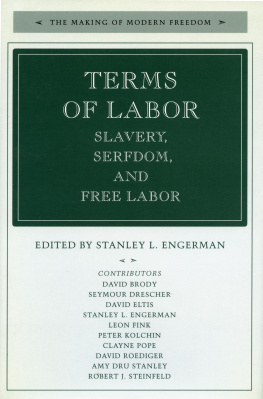This introduction is based upon the discussions at the two conferences held on this volume, and I wish to acknowledge the help provided by all the participants, including the three discussants at the first conferenceRobert E. Gallman, David Montgomery, and Douglass C. North. In addition, for help in planning these conferences I wish to thank Ava Baron and Richard W. Davis. I have benefited from comments made on an early draft of this paper by Seymour Drescher, David Eltis, Sarah Pomeroy, and Robert Steinfeld.
There may have been early exceptions to this, by groups willing to accept a low standard of living, with their wants easily satisfied. See Marshall Sahlinss discussion of hunter-gatherers in The Original Affluent Society, in his Stone Age Economics (New York, 1972), 139. For a related argument, that the Industrial Revolution emerged with increased wants and increased working time and effort, see Jan deVries, The Industrial Revolution and the Industrious Revolution, Journal of Economic History 54 (June 1994): 24974.
M. I. Finley has commented that in the context of universal history, free labour, wage labour, is the peculiar institution. For most of the millennia of human history in most parts of the world... labour for others was normally performed under compulsion, because of superior force or of status or of such conditions as debt. A Peculiar Institution? Times Literary Supplement 3887 (July 2, 1976): 81921. Two astute observers of the late eighteenth century noted the relative absence of free labor at that time. Adam Smith claimed that slavery had been abolished in only a small part of Europe and some parts of America. Lectures on jurisprudence (Oxford, 1978; Reports of 17621763 and 1766, Glasgow University Library), 181. Arthur Young estimated that over 95 percent of the inhabitants of the world lived under arbitrary governments, living as miserable slaves of despotic tyrants. Arthur Young, Political Essays ( New York, 1970; first pub. 1772), 1922. Few at this time argued for the general freeing of slaves.
For comparisons of slavery and serfdom, see Stanley L. Engerman, Slavery, Serfdom and Other Forms of Coerced Labor: Similarities and Differences, in M. L. Bush, ed., Serfdom and Slavery: Studies in Legal Bondage (London, 1996), 1841.
Also suggestive is the long duration of British acts controlling labor (and some non-labor) matters under the rubric of master and servant, before the later change to employer and employee.
See Jerome Blum, The End of the Old Order in Europe (Princeton, NJ, 1978); and Stanley L. Engerman, Emancipations in Comparative Perspective : A Long and Wide View, in Gert Oostinde, ed., Fifty Years Later: Antislavery, Capitalism and Modernity in the Dutch Orbit (Leiden, 1995), 22341.
There were, of course, aberrations even in the western world in the twentieth century, as exemplified by the Soviets and their satellites, and by Nazi Germany; and not all nations have been interested in attaining the goal of freedom for its inhabitants. While these societies did have forced labor, in the Russian case of their own nationals, for neither the Soviets nor the Nazis was the primary purpose of forced labor based upon economic needs. Some specific industries, such as construction and mining, relied on forced labor in the Soviet Union. In general this accounted for only a small part of the Soviet national output, although this share no doubt exceeded that from forced labor in Nazi Germany. The continuing range of labor and other problems has meant that the Anti-Slavery Society remains actively involved throughout the world. For some earlier post-World War II background, see C. W. W. Greenidge, Slavery (London, 1958), as well as the many current publications of the Anti-Slavery Society.
Thus the innovations related to sugar production led to the development of the plantation using the gang system of labor, among the most distasteful forms of working conditions for free labor.
Defining political freedom in different societies goes beyond the ability of many in the population to vote. If wealth and other factors give differential power to influence elections to certain groups, then the precise meaning of democratic politics may be unclear. This distinction was drawn upon in the debates about the extent of democracy, even among whites, in colonial America. See, for example, the survey by John M. Murrin, Political Development, in Jack P. Greene and J. R. Pole, eds., Colonial British America: Essays in the New History of the Early Modern Era (Baltimore, 1984), 40856.
William Blackstone stated, in regard to property in Negro servants, who were bought when captives, that accurately speaking, that property consists rather in the perpetual service, than in the body or person, of the captive, Commentaries on the Laws of England, vol. 2: On the Rights of Things (Chicago, 1979; first pub. 1766), 402. A similar distinction was made by several proslavery advocates in the antebellum South, most prominently by Henry Hughes in his system of warranteeism. See Douglas Ambrose, Henry Hughes and Proslavery Thought in the Old South (Baton Rouge, LA, 1996).
The term herrenvolk democracy has been used to define the cases of cross-class coalitions against outsider groups. For an explanation of the origins of American Slavery, American Freedom in colonial Virginia, see the book of that title by Edmund S. Morgan (New York, 1975). Similarly, freedom for males was often argued while advocating limited rights for women and children.
Indeed, one of the paradoxes of slavery and serfdom is that its end on economic grounds, as with the later years of the Roman Empire, should leave laborers at subsistence, with no choice but to work, so that freedom comes about with everyone at subsistencea work or starve position. For various presentations of this point see H. J. Nieboer, Slavery as an Industrial System: Ethnological Researches (New York, 1971; first pub. 1910), 41727; George Tucker, Progress of the United States in Population and Wealth in Fifty Years (New York, 1964; first pub. 1855), 10818; and M. I. Finley, Ancient Slavery and Modern Ideology (New York, 1980), 12349.
Adam Smith, The Wealth of Nations (Oxford, 1976; first pub. 1776), bk. 5. For expansions on this point see Jacob Viner, Adam Smith and Laissez Faire, Journal of Political Economy 35 (April 1927): 198232; and Nathan Rosenberg, Some Institutional Aspects of the Wealth of Nations, Journal of Political Economy 68 (Dec. 1960): 55770.
The extent to which the desired degree of exploitation varied, depending upon the income wanted by the lords, was noted by Max Weber. In his chapter on the manor in medieval times Weber comments that the mode of life of the lord was little different from that of the peasant. Thus the walls of the stomach set the limits to his exploitation of the peasant as Karl Marx observed. Max Weber, General Economic History (New York, 1961; first pub. 1927), 67.
The literature of the eighteenth century pointed to the dangers of individuals becoming slaves to their passions, an argument for a more rational approach to life. On the discussion of passions more generally, see Albert O. Hirschman, The Passions and the Interests: Political Arguments for Capitalism before its Triumph (Princeton, NJ, 1977). This concern with the loss of power of autonomous action can be traced back to the Greek Stoics, as shown by Peter Gamsey, Ideas of Slavery from Aristotle to Augustine (Cambridge, 1996), 12852. Several centuries later Augustine claimed, in effect, that slavery was unavoidable, for we are slaves either of God or of sin. Gamsey, Ideas of Slavery, 20619.












